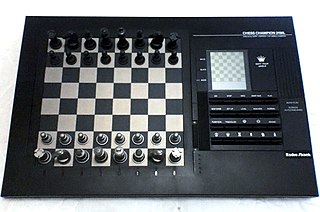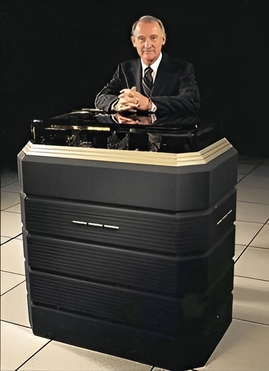Related Research Articles

Garry Kimovich Kasparov is a Russian chess grandmaster, former World Chess Champion (1985–2000), political activist and writer. His peak FIDE chess rating of 2851, achieved in 1999, was the highest recorded until being surpassed by Magnus Carlsen in 2013. From 1984 until his retirement from regular competitive chess in 2005, Kasparov was ranked world no. 1 for a record 255 months overall. Kasparov also holds records for the most consecutive professional tournament victories (15) and Chess Oscars (11).

A supercomputer is a type of computer with a high level of performance as compared to a general-purpose computer. The performance of a supercomputer is commonly measured in floating-point operations per second (FLOPS) instead of million instructions per second (MIPS). Since 2017, supercomputers have existed which can perform over 1017 FLOPS (a hundred quadrillion FLOPS, 100 petaFLOPS or 100 PFLOPS). For comparison, a desktop computer has performance in the range of hundreds of gigaFLOPS (1011) to tens of teraFLOPS (1013). Since November 2017, all of the world's fastest 500 supercomputers run on Linux-based operating systems. Additional research is being conducted in the United States, the European Union, Taiwan, Japan, and China to build faster, more powerful and technologically superior exascale supercomputers.

The Cray-1 was a supercomputer designed, manufactured and marketed by Cray Research. Announced in 1975, the first Cray-1 system was installed at Los Alamos National Laboratory in 1976. Eventually, eighty Cray-1s were sold, making it one of the most successful supercomputers in history. It is perhaps best known for its unique shape, a relatively small C-shaped cabinet with a ring of benches around the outside covering the power supplies and the cooling system.
Control Data Corporation (CDC) was a mainframe and supercomputer company that in the 1960s was one of the nine major U.S. computer companies, which group included IBM, the Burroughs Corporation, and the Digital Equipment Corporation (DEC), the NCR Corporation (NCR), General Electric, and Honeywell, RCA and UNIVAC. For most of the 1960s, the strength of CDC was the work of the electrical engineer Seymour Cray who developed a series of fast computers, then considered the fastest computing machines in the world; in the 1970s, Cray left the Control Data Corporation and founded Cray Research (CRI) to design and make supercomputers. In 1988, after much financial loss, the Control Data Corporation began withdrawing from making computers and sold the affiliated companies of CDC; in 1992, Cray established Control Data Systems, Inc. The remaining affiliate companies of CDC currently do business as the software company Ceridian.

Computer chess includes both hardware and software capable of playing chess. Computer chess provides opportunities for players to practice even in the absence of human opponents, and also provides opportunities for analysis, entertainment and training. Computer chess applications that play at the level of a chess grandmaster or higher are available on hardware from supercomputers to smart phones. Standalone chess-playing machines are also available. Stockfish, Leela Chess Zero, GNU Chess, Fruit, and other free open source applications are available for various platforms.
Cray Inc., a subsidiary of Hewlett Packard Enterprise, is an American supercomputer manufacturer headquartered in Seattle, Washington. It also manufactures systems for data storage and analytics. Several Cray supercomputer systems are listed in the TOP500, which ranks the most powerful supercomputers in the world.
ETA Systems was a supercomputer company spun off from Control Data Corporation (CDC) in the early 1980s in order to regain a footing in the supercomputer business. They successfully delivered the ETA-10, but lost money continually while doing so. CDC management eventually gave up and folded the company.

Crafty is a chess program written by UAB professor Dr. Robert Hyatt, with continual development and assistance from Michael Byrne, Tracy Riegle, and Peter Skinner. It is directly derived from Cray Blitz, winner of the 1983 and 1986 World Computer Chess Championships. Tord Romstad, co-author of Stockfish, described Crafty as "arguably the most important and influential chess program ever".

David Neil Laurence Levy is an International Master of chess who plays for Scotland, and a businessman. He is noted for his involvement with computer chess and artificial intelligence, and as the founder of the Computer Olympiads and the Mind Sports Olympiads. He has written more than 40 books on chess and computers.
World Computer Chess Championship (WCCC) is an event held periodically since 1974 where computer chess engines compete against each other. The event is organized by the International Computer Games Association. It is often held in conjunction with the World Computer Speed Chess Championship and the Computer Olympiad, a collection of computer tournaments for other board games. Instead of using engine protocols, the games are played on physical boards by human operators.

The Cray-3 was a vector supercomputer, Seymour Cray's designated successor to the Cray-2. The system was one of the first major applications of gallium arsenide (GaAs) semiconductors in computing, using hundreds of custom built ICs packed into a 1 cubic foot (0.028 m3) CPU. The design goal was performance around 16 GFLOPS, about 12 times that of the Cray-2.
Robert Morgan Hyatt is an American computer scientist and programmer. He co-authored the computer chess programs Crafty and Cray Blitz which won two World Computer Chess Championships in the 1980s. Hyatt was a computer science professor at the University of Southern Mississippi (1970–1985) and University of Alabama at Birmingham (1988–2016).

Sargon is a line of chess-playing software for personal computers. The original SARGON from 1978 was written in assembly language by Dan and Kathleen "Kathe" Spracklen for the Z80-based Wavemate Jupiter II.
Advanced chess is a form of chess in which each human player uses a computer chess program to explore the possible results of candidate moves. Despite this computer assistance, it is the human player who controls and decides the game.
Chess was a pioneering chess program from the 1970s, written by Larry Atkin, David Slate and Keith Gorlen at Northwestern University. Chess ran on Control Data Corporation's line of supercomputers. Work on the program began in 1968 while the authors were graduate students at the university. The first competitive version was Chess 2.0 which gradually evolved to Chess 3.6 and was rewritten as the 4.x series. It dominated the first computer chess tournaments, such as the World Computer Chess Championship and ACM's North American Computer Chess Championship. At the ACM event, Chess won eight of the ten tournaments held from 1970 to 1979. NWU Chess adopted several innovative or neglected techniques including bitboard data structures, iterative deepening, transposition tables, and an early form of forward pruning later called futility pruning. The 4.x versions were the first programs to abandon selective search in favor of full-width fixed-depth searching.

Alexander Mikhailovich Chernin is a Soviet-born Hungarian chess grandmaster and trainer.
This article documents the progress of significant human–computer chess matches.

A chess tournament is a series of chess games played competitively to determine a winning individual or team. Since the first international chess tournament in London, 1851, chess tournaments have become the standard form of chess competition among serious players.
Harry Lewis Nelson is an American mathematician and computer programmer. He was a member of the team that won the World Computer Chess Championship in 1983 and 1986, and was a co-discoverer of the 27th Mersenne prime in 1979. He also served as editor of the Journal of Recreational Mathematics for five years. Most of his professional career was spent at Lawrence Livermore National Laboratory where he worked with some of the earliest supercomputers. He was particularly noted as one of the world's foremost experts in writing optimized assembly language routines for the Cray-1 and Cray X-MP computers. Nelson has had a lifelong interest in puzzles of all types, and since his retirement in 1991 he has devoted his time to his own MiniMax Game Company, a small venture that helps puzzle inventors to develop and market their products.
References
- ↑ Hyatt, R.M.; Nelson, H.L. (1990). "Chess and supercomputers: Details about optimizing Cray Blitz". Proceedings SUPERCOMPUTING '90. Ieeexplore.ieee.org. pp. 354–363. doi:10.1109/SUPERC.1990.130041. ISBN 0-8186-2056-0. S2CID 2277304.
- ↑ Hyatt R.A., Gower A.E., Nelson H.L. (1988) Cray Blitz. In: Levy D. (eds) Computer Chess Compendium. Springer, New York, NY
- ↑ "Science Watch; and Still Champion: Cray's Chess Computer". The New York Times. 1986-06-17. ISSN 0362-4331 . Retrieved 2020-02-06.